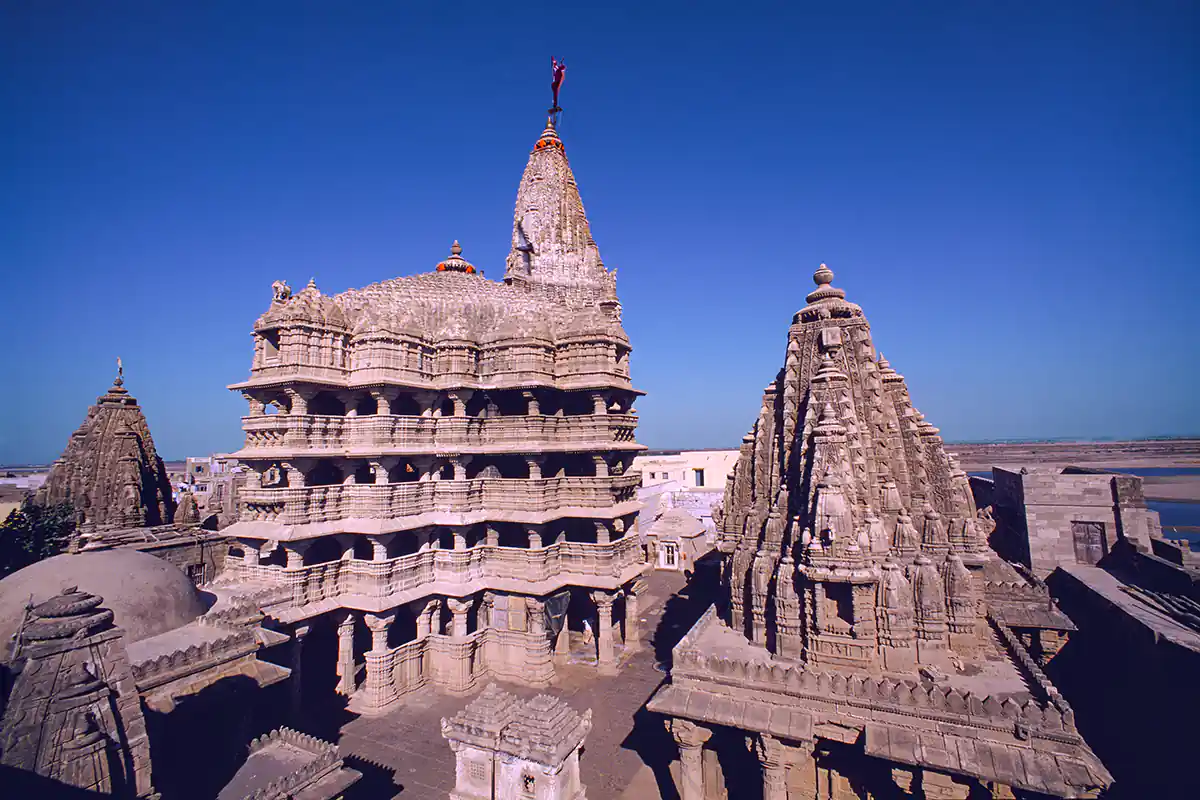Dwarka
Among India's many pilgrimage sites, particular ones are traditionally viewed as being especially holy for various mythological reasons. Preeminent among this listing are the Sapta Puri, or Seven Sacred Cities, and the four Dhamas, or "Divine Abodes" (for additional information on the Dhamas, see the photos and text for Rameshvaram on this website). The Seven Sacred Cities of Ayodhya, Mathura, Haridwar, Banaras, Kanchi, Ujjain, and Dwarka are known as Mokshada, meaning 'Bestower of Liberation,' and these sites are believed to confer liberation upon all persons who die within their boundaries. One of these seven sacred cities, Dwarka, is also listed among the Four Divine Abodes.
Seldom visited by Westerners because of its remote location in the western state of Gujarat, the fascinating and magnificent Jagatmandir temple is bordered on one side by the ocean coast and on the other side by the town of Dwarka. One of India's oldest and most revered pilgrimage sites, Dwarka's archaeological and historical background is shrouded in mystery. Mythologically, Dwarka - or Dvaravati as it is known in Sanskrit - was the site chosen by Garuda, the Divine Eagle, who brought Krishna here when he departed Mathura. Krishna founded the beautiful city and lived there until he died (according to legend) in 3102 BC. Scholars confer that the oldest parts of the Jagatmandir temple may only date to the reconstructions of the Gupta period in 413 AD.
In the 7th century, the sage Shankaracharya established four great monasteries in the cardinal directions of the country (Sringeri in the south, Puri in the east, Joshimath in the north, and Dwarka in the west). This emphasis on Dwarka further increased its importance as a pilgrimage destination. The original temples were destroyed during the 11th century by Muslim armies; frequently rebuilt, they continued to be attacked by the Muslims through the 15th century. The existing temple of Jagatmandir, also known as Sri Dwarkadish, dates from a 1730 rebuilding. It is 52 meters tall and enshrines an idol called Sri Ranchhodrayji. The temple stands five stories tall and is built on 72 pillars.
Students of the science of archaeoastronomy will recognize the significance of this number 72, one of the most important numbers in the so-called ‘precessional code’ (re)discovered by the scholars Santillana and von Dechend. The astronomical phenomenon of precession concerns the very slow wobble of the earth's axis and its effect on earth-bound observers of a gradual and cyclical slippage of the zodiac belt against the sun's rising point. This precessional slippage operates at the rate of one degree every 72 years, meaning that each constellation houses the sun for an average of 2160 years. All twelve constellations take 25,920 years to pass completely through the cycle. These numbers of 72, 2160, 25,920, and various permutations of them have been shown by Santillana and von Dechend, in their book Hamlet’s Mill, to be mysteriously present in ancient myths and sacred architecture worldwide. While little archaeoastronomical study of the Jagatmandir temple has so far been conducted, the presence of the number 72 in so important a part of the temple’s architecture suggests that future studies will result in many fascinating revelations.
Besides being a Sapta Puri, a Dhama, and a Shankaracharya Mutt, many pilgrims also visit Dwarka because of its association with the great bhakti saint Mira Bai. One of India's most popular saints, Mira Bai, renounced her splendid life as the wife of a powerful 16th-century king to dedicate her days to the worship of Lord Krishna. Mira Bai followed the spiritual path known as Bhakti Yoga, characterized by a devotional love of god. Much easier to practice (and perhaps more efficient at producing spiritual enlightenment) than other yogic methods, Bhakti Yoga is the primary religious method used by India's teeming masses. The path of the Bhakti yogi is essentially the practice of invoking the presence of the divine through the adoration of a statue, icon, or painting of a deity. In Mira Bai's case, as with many other saints in India's long history, this invocation called forth not only the felt presence of the deity but actually a living, moving form of Krishna. Similar to the physical apparitions of Mary and Christ to devoted Christians, Krishna visited Mira Bai to eat, sing, dance, and play with her. Mira Bai lived the final years of her life in Dwarka, where she wrote Krishna, her immortal love poems. Krishna, the preeminent devotional deity in Hinduism, is revered here, and legions of bhakti yogis such as Mira Bai have infused the temple with the power of love. The pilgrimage shrine of Jagatmandir in Dwarka is thus highly charged with the quality or energy of devotion and will awaken and amplify that quality in visiting pilgrims.
Ancient legends of Dwarka tell that the holy city was long ago entirely swept away by a great wave of water. This legend, disregarded by contemporary historians and archaeologists, has recently been given credence by findings of the new science of inundation mapping, which produces accurate models of ancient shorelines at specific dates. Oceanographic studies have further supported the legend, proving the existence of submerged temple structures off the coast of Dwarka.
Other sacred sites associated with Krishna are Mathura, Vrindivan, Gokula, Barsana, Govardhana and Kuruksetra.
For additional information:

Martin Gray is a cultural anthropologist, writer and photographer specializing in the study of pilgrimage traditions and sacred sites around the world. During a 40 year period he has visited more than 2000 pilgrimage places in 160 countries. The World Pilgrimage Guide at sacredsites.com is the most comprehensive source of information on this subject.

